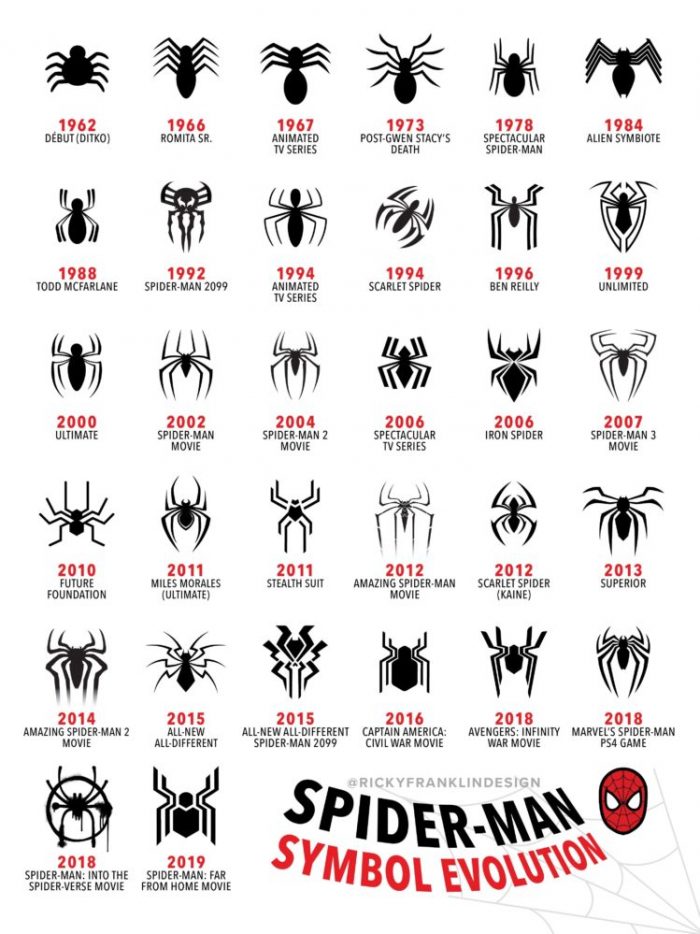
Spider-Man has been around since the 1930s, but his most iconic symbol wasn’t designed until 1969. It’s also undergone a few evolutions since then. Let’s take a look at how this iconic symbol came to be what it is today!
1962: Steve Ditko is the main creator of Spider-Man and his signature symbol.
The original creator of Spider-Man, Steve Ditko is responsible for the character’s signature spider symbol. Though it has undergone slight modifications over time, this design has been used in every movie and comic book iteration since 1962. It also appears on merchandise from toys to T-shirts to lunch boxes–and even tattooed on people’s bodies!
The Spider-Man signature symbol has been engraved into people’s minds. As its influence continues to expand, not only T-shirts but also hats, hoodies, jackets and other apparel have appeared with the Spider-Man symbol. Even many accessories as well as decorative items have their elements. As a Spider-Man fan, who wants to express their preferences and personality, you can custom patches to wear on the clothes. Not only can you choose your favorite symbol, but you can also add your own design and colors. At GS-JJ, it can all be done!
1967: Stan Lee created Spider-Man’s famous catchphrase, “With great power comes great responsibility.”
Stan Lee is the co-creator of Spider-Man and many other famous superheroes. He was born in 1922, and died in 2018. His catchphrase, “With great power comes great responsibility,” is one of the most iconic lines in comic book history.
1969 – 1978: The famous logo that adorns nearly all of Spider-Man’s merchandise was designed by Jim Starlin in the late ’70s.
The logo that adorns nearly all of Spider-Man’s merchandise was designed by Jim Starlin in the late ’70s. Jim Starlin is a comic book artist and writer who has worked on many titles including The Avengers, Captain Marvel, Iron Man, and Warlock. He has also created some of Marvel Comics’ most iconic characters such as Gamora (Guardians of the Galaxy), Thanos (Avengers: Infinity War), Drax The Destroyer (Guardians Of The Galaxy) and more recently Thane Kyrell from Rogue One: A Star Wars Story. In addition to designing the famous Spider-Man symbol we know today, he also created some other memorable logos for other superheroes like Thor’s hammer Mjolnir which features a circle surrounded by eight triangles representing lightning bolts pointing towards its outer edge with three lines coming out from each side forming an infinity symbol along with two circles inside each other representing eternity; Captain America’s shield which features 13 stripes representing unity between colonies during America’s Revolutionary War along with 50 white stars surrounding them symbolizing unity within states after independence; Iron Man’s chestplate featuring red rays emanating from his chest area representing power generated through his suit etc
1972: Other artists took over Peter Parker and his alter ego, developing their own interpretations of the character.
The early ’70s were a time of change for the superhero. Spider-Man’s creators wanted him to be a modern superhero who was more accessible to the audience, and other artists took over Peter Parker and his alter ego, developing their own interpretations of the character. By this point, Spider-Man had become a household name; he was featured on cereal boxes and lunchboxes as well as in comics and television shows. After Stan Lee stepped down as editor-in-chief of Marvel Comics (he returned briefly in 2000), Jack Kirby created The Fourth World series with him that featured Darkseid–a villainous New God who appeared in DC Comics’ Justice League titles before appearing himself in 1986’s Superman #3 by John Byrne–and Orion: The Hunter from Another World!
1990s – 2000s: Tom Holland brought a new approach to Spider-Man that captured many people’s imagination.
The Spiderman symbol was first introduced during the 1990s, when Tom Holland donned the red and blue suit for his role as Peter Parker in Captain America: Civil War. It’s also worth noting that he is the youngest actor to play Spider-Man on screen (at age 19). It’s been said that Holland’s portrayal of this superhero is more realistic and vulnerable than previous actors; many people have praised his performance as being very naturalistic. In fact, some fans would even argue that he did such a good job portraying Peter Parker that it made them forget about Tobey Maguire or Andrew Garfield entirely!
We’ve come a long way since the 1930s!
The Spiderman symbol is a great example of how a logo can be re-invented over time. The original design was created by Steve Ditko in 1962 and has been used by Marvel Comics ever since, but it’s undergone several changes along the way. The first version featured just two lines to make up the webbing around Spiderman’s face and torso–no spider! This was soon changed to include one small red spider on top left corner of his forehead (which you can see above). In 1973 another redesign gave us our current iteration: three large black circles with white outlines surrounding an image of Peter Parker’s face inside them all connected together by thick webs coming out from behind his head like strands from some kind of spiky hairstyle he might have had back then…or maybe even still has today?
Spider-Man has been around for over 80 years, and he’s evolved a lot over that time. The most notable change is in his appearance–the spider symbol on his chest has gone through many different incarnations before finally becoming what we know today. It’s interesting to see how each artist brought their own unique style into the world of comics while staying true to what makes Spider-man such an iconic figure among fans everywhere!
